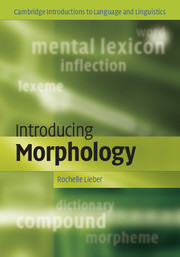
-
The digital format of this book is no longer available to purchase from Cambridge Core. Other formats may be available.
-
Select format
-
- Publisher:
- Cambridge University Press
- Publication date:
- 05 June 2012
- 24 December 2009
- ISBN:
- 9780511808845
- Dimensions:
- Weight & Pages:
- Dimensions:
- Weight & Pages:
You may already have access via personal or institutional login
Book description
Morphology is the study of how words are put together. A lively introduction to the subject, this textbook is intended for undergraduates with relatively little background in linguistics. Providing data from a wide variety of languages, it includes hands-on activities such as 'challenge boxes', designed to encourage students to gather their own data and analyse it, work with data on websites, perform simple experiments, and discuss topics with each other. There is also an extensive introduction to the terms and concepts necessary for analysing words. Topics such as the mental lexicon, derivation, compounding, inflection, morphological typology, productivity, and the interface of morphology with syntax and phonology expose students to the whole scope of the field. Unlike other textbooks it anticipates the question 'Is it a real word?' and tackles it head on by looking at the distinction between dictionaries and the mental lexicon.
Reviews
‘… strikes just the right balance between explaining morphology and encouraging the student to discover what it's about. Its hands-on approach is well suited to getting undergraduates interested in the subject.’
S. J. Hannahs - Newcastle University
‘The ideal textbook, pedagogically sound, taking beginning students all the way from the basics to advanced theoretical questions. The 'how-to' sections, the 'challenges' and the end-of-chapter exercises are all designed to encourage students to do morphology for themselves.’
Laurie Bauer - Victoria University of Wellington, New Zealand
Contents
Metrics
Full text views
Full text views help Loading metrics...
Loading metrics...
* Views captured on Cambridge Core between #date#. This data will be updated every 24 hours.
Usage data cannot currently be displayed.
Accessibility standard: Unknown
Why this information is here
This section outlines the accessibility features of this content - including support for screen readers, full keyboard navigation and high-contrast display options. This may not be relevant for you.
Accessibility Information
Accessibility compliance for the PDF of this book is currently unknown and may be updated in the future.


